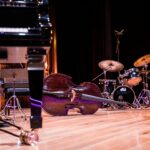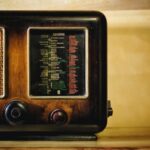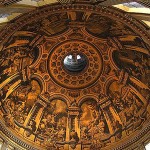The Feast
by John Roth
That little farmhouse on a quarter of land in Southern Minnesota is gone now, having been a warm and comfortable home to Norwegian immigrant farmers for 100 years. It was plowed under and returned to service as a cornfield after its last resident, my Uncle Stan, died in the year nineteen hundred and eighty-six.
Picture the kitchen. Walk in, (the floor squeaking) and stand beside a big dark brown crank phone. Beside it, a rack containing kitchen supplies, adjoining a tall white rectangular metal cabinet, a refrigerator containing bottles of “St. James” creme soda and orange soda and cola, along with an offbeat regional drink called Dr. Pepper, its darkish liquid inside offset starkly by a round white logo with the numbers “10 2, and 4” placed as if on a clock dial.
Then the windows out to the grove, framed with frilly white curtains. Cabinets with boxes of cereal, (“breakfast food” was the country term), a door to the mysterious upstairs, another to a room that would one day become the bathroom, pump handle on a table with a large white bowl for the water, beside a big cast iron stove with corn cobs burning. A box of giant stick matches whose blue and white tips could rub against anything and suddenly, wonderfully burst into a smoky, pungent ball of flame. Then the door to the living room.
The big kitchen shrunk when filled with Grandma Petra, a large and benign personage, Grandpa Axel, half her size, Uncle Stan in giant Oshkosh overalls and heavy field boots. The farmers came in looking strange, their necks red from the sun, their pressed-down hair and bands of indentation on the skin of their foreheads remembering the colorful seedcorn caps they had removed upon entering the house. Grampa Axel invited the kids to come out to the barn pump for water. He took a steel bucket, hung it on the faucet, switched on an electric pump, filled the bucket. The kids stared at cows and steers, who stared back as if frozen onto the backdrop of a line of trees. Axel ambled toward the house, bucket in one arm, the other stretched out long and horizontal for balance. The kids behind, imitating him. He brought in the bucket and filled the large white bowl on the counter next to the kitchen pump. There we washed, the farmers using gritty Lava to make their gnarled, hairy hands and long yellowed nails almost clean.
On some occasions, there were a dozen or so assorted relatives, all gathered close around for supper. Supper was not dinner, Supper was an additional meal, just a bit to eat and a bit to drink, and then back to work. A giant jar of jam and plates with towers of white bread. A big pitcher of Kool-Aid, what they referred to as “nectar.” Dark red liquid, without sufficient sugar for the spoiled palettes of city kids. Weak coffee was poured into cups on saucers, and sugar lumps were plopped in. The adults bent over the table like giant city oak trees when they join in the middle of the street, their fingers like gnarly tendrils somehow squeezing through the tiny holes on the coffee cups. We heard conversation punctuated by the spooky sound of swallows of coffee croaking down the adult throats. Axel clicking his artificial teeth and chuckling softly at what the kids said, Stanley blinking from a twitch he developed on a carrier in the Pacific fleet, exotic indigo tattoos bulging from his tee-shirt, speaking in little shouts in his high-pitched Norwegian brogue, sounding as if he were on the red Farmall tractor shouting to a passing neighbor. We watched the mousetraps scattered about, hoping to get lucky and see a capture.
Petra did all the cooking, and most of the serving, as Axel’s mother had done when she was the woman of the house, beginning in about 1920 when this house was raised to replace another, which had been raised to replace the sod house that Paul and Ingeborg, the immigrants, had inhabited since 1875.
There were no elaborate prayers, no handholding or singing of hymns at that table, just a quick Come Lord Jesus with hands folded and heads bowed, and then the food and chit chat. Then back to work.
We were all well fed. Petra saw to that.
After dinner, Petra gathered up the leftovers, put them into a small round blackened frying pan, and took it out the front door, calling out, in a high pitched falsetto, “hyuh, hyuh, hyuh!” Two dogs materialized instantly and collected themselves around the pan to devour the treat. Smoky, the black one, and Pepper, a yellow and white one.
We walked into the living room, the adults bending to get through the door without banging their heads on the jamb. The room resembled an igloo. The brown metal stove took up most of the space, faithfully giving off its pungent heat .
Adults sat close to the floor on an old couch, and on pink plastic sculptured chairs, Petra’s concession to modernity. Kids scurried around the floor or became part of their parents’ knees, trying to get attention.
There was a small brown desk, above it a thermometer from a local funeral home, a television in the corner, with its weird little box that attempted, with only partial success, and constant adjustment, to receive programs from a tower miles away. A pile of “Farmer” magazines. People filled the room.
On dark nights we sat, connected, overlapping, my Father, a city man, asking Stan routine questions about the crop and the weather, and my older sister and I quarreling over who got to hold Stan’s guitar and pretend to play. We wondered at the roar of crickets, the lowing of cattle and the wind in the country trees.
If you tiptoed through the crooked and creaky gray-painted door to Axel and Petra’s bedroom, and peeked behind the door, you saw a brown cabinet radio. Above it was a reproduction of Leonardo’s “Last Supper”, the sole piece of art in the house. The disciples gathered into a small room, seated around Jesus for a quick bite, then off to work. Around the frame of the picture were other pictures. The tiny school photos of the grandchildren. Sharon, the eldest. Darryl, Lynnette, and Gaylene, her siblings, the small-town cousins. Julie and Mary, the farm cousins. Cheryl and Christine, my sisters, and I, the city kids. Not just one picture of each, but every picture from kindergarten through the present, having arrived, one at a time, in letters from Petra’s children. Little rectangles, some black and white, some color, crammed one at a time through the years by Petra’s large fingers between the frame and its glass, around the long table, in that brown frame, touching, overlapping.
We never stayed long. A weekend, perhaps an extra day and night.










When I lived in Alberta, Canada I traveled the countryside often and witnessed many an old abandoned farmhouse… As I would drive by it was always a great desire to know the love and life that transpired inside those houses through the years… Your piece here sparks my imagination again! Thanks John!
Great descriptive writing, John! It puts the reader right into the setting of the past in rural MN. It also echoed some of my past memories as I am certain it will for others. Have you more writings to share? Mange takk!
Your words in writing about your farm memories I definitely relate to. I always think about those old vacant farm sites when riding through the countryside – “If they could talk there would be chapters and chapters of life to tell us.” My first thought – put this story to MUSIC with a little NORSK!! Takk